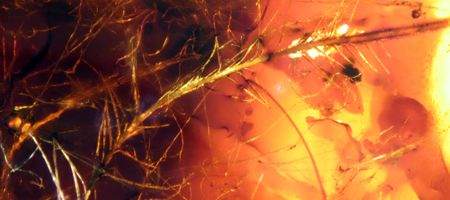A University of Alberta research team has discovered a remarkable collection of Cretaceous feathers trapped in tree resin.

The eleven 80 million-year-old protofeathers may derive from non-avian dinosaurs. Some are very similar to the plumage of modern birds, including those that can swim under water.
The feathers were discovered in the vast amber collections at the Royal Tyrrell Museum in southern Alberta, originally from Canada’s amber deposits near Grassy Lake in southwestern Alberta.
“Most of the feather specimens were probably blown into contact with the sticky surface of the resin and encapsulated by subsequent resin flows,” says paleontology graduate student Ryan McKellar, who discovered the specimens.
“The amber preserves microscopic detail of the feathers and even their pigment or colour. I would describe the colours as typically ranging from brown to black.”
No dinosaur or avian fossils were found in direct association with the specimens, but comparison with fossilized feathers found in rock strongly suggest that some of the specimens are from dinosaurs – probably small theropods.
Many are very similar to those of modern birds like the grebe, which can swim underwater. The feathers can take on water giving the bird the ballast required to dive more effectively.
McKellar says the find shows that numerous evolutionary stages of feathers were present in the late Cretaceous period, and that plumage served a range of functions in both dinosaurs and birds.






